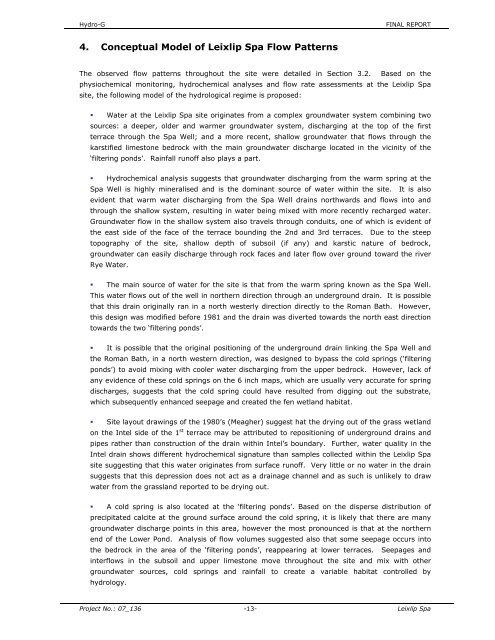Hydro G Final report - Kildare.ie
Hydro G Final report - Kildare.ie
Hydro G Final report - Kildare.ie
Create successful ePaper yourself
Turn your PDF publications into a flip-book with our unique Google optimized e-Paper software.
<strong>Hydro</strong>-G FINAL REPORT<br />
4. Conceptual Model of Leixlip Spa Flow Patterns<br />
The observed flow patterns throughout the site were detailed in Section 3.2. Based on the<br />
physiochemical monitoring, hydrochemical analyses and flow rate assessments at the Leixlip Spa<br />
site, the following model of the hydrological regime is proposed:<br />
Water at the Leixlip Spa site originates from a complex groundwater system combining two<br />
sources: a deeper, older and warmer groundwater system, discharging at the top of the first<br />
terrace through the Spa Well; and a more recent, shallow groundwater that flows through the<br />
karstif<strong>ie</strong>d limestone bedrock with the main groundwater discharge located in the vicinity of the<br />
‘filtering ponds’. Rainfall runoff also plays a part.<br />
<strong>Hydro</strong>chemical analysis suggests that groundwater discharging from the warm spring at the<br />
Spa Well is highly mineralised and is the dominant source of water within the site. It is also<br />
evident that warm water discharging from the Spa Well drains northwards and flows into and<br />
through the shallow system, resulting in water being mixed with more recently recharged water.<br />
Groundwater flow in the shallow system also travels through conduits, one of which is evident of<br />
the east side of the face of the terrace bounding the 2nd and 3rd terraces. Due to the steep<br />
topography of the site, shallow depth of subsoil (if any) and karstic nature of bedrock,<br />
groundwater can easily discharge through rock faces and later flow over ground toward the river<br />
Rye Water.<br />
The main source of water for the site is that from the warm spring known as the Spa Well.<br />
This water flows out of the well in northern direction through an underground drain. It is possible<br />
that this drain originally ran in a north westerly direction directly to the Roman Bath. However,<br />
this design was modif<strong>ie</strong>d before 1981 and the drain was diverted towards the north east direction<br />
towards the two ‘filtering ponds’.<br />
It is possible that the original positioning of the underground drain linking the Spa Well and<br />
the Roman Bath, in a north western direction, was designed to bypass the cold springs (‘filtering<br />
ponds’) to avoid mixing with cooler water discharging from the upper bedrock. However, lack of<br />
any evidence of these cold springs on the 6 inch maps, which are usually very accurate for spring<br />
discharges, suggests that the cold spring could have resulted from digging out the substrate,<br />
which subsequently enhanced seepage and created the fen wetland habitat.<br />
Site layout drawings of the 1980’s (Meagher) suggest hat the drying out of the grass wetland<br />
on the Intel side of the 1 st terrace may be attributed to repositioning of underground drains and<br />
pipes rather than construction of the drain within Intel’s boundary. Further, water quality in the<br />
Intel drain shows different hydrochemical signature than samples collected within the Leixlip Spa<br />
site suggesting that this water originates from surface runoff. Very little or no water in the drain<br />
suggests that this depression does not act as a drainage channel and as such is unlikely to draw<br />
water from the grassland <strong>report</strong>ed to be drying out.<br />
A cold spring is also located at the ‘filtering ponds’. Based on the disperse distribution of<br />
precipitated calcite at the ground surface around the cold spring, it is likely that there are many<br />
groundwater discharge points in this area, however the most pronounced is that at the northern<br />
end of the Lower Pond. Analysis of flow volumes suggested also that some seepage occurs into<br />
the bedrock in the area of the ‘filtering ponds’, reappearing at lower terraces. Seepages and<br />
interflows in the subsoil and upper limestone move throughout the site and mix with other<br />
groundwater sources, cold springs and rainfall to create a variable habitat controlled by<br />
hydrology.<br />
Project No.: 07_136 -13-<br />
Leixlip Spa
















